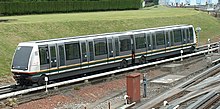
Back Transporte público guiado Spanish Transports guidés urbains automatiques French 自動案内軌条式旅客輸送システム Japanese 무인궤도교통 Korean Automated guideway transit Dutch Автоматизированная система перевозки пассажиров Russian
This article needs additional citations for verification. (January 2024) |

| Automated track-bound traffic |
|---|
| Automatic train operation |
| Lists of automated train systems |
| Related topics |


An automated guideway transit (AGT) or automated fixed-guideway transit[1] or automatic guideway transit[2] system is a type of fixed guideway transit infrastructure with a riding or suspension track that supports and physically guides one or more driverless vehicles along its length.[3] The vehicles are often rubber tired or steel wheeled, but other traction systems including air cushion, suspended monorail and maglev have been implemented. The guideway provides both physical support, like a road, as well as the guidance. An automated line can be cheaper to run than a conventional line, due to the shorter trains and stations.[4]
AGT covers a wide variety of systems, from limited people mover systems commonly found at airports,[3] to more complex automated train systems like the Vancouver SkyTrain. In the people mover role the term "automated people mover" (APM) is sometimes used, although this distinction is relatively rare because most people movers are automated. Larger systems span a variety of conceptual designs, from subway-like advanced rapid transit (ART) systems to smaller (typically two to six passengers) vehicles known as personal rapid transit (PRT) which offer direct point-to-point travel along a switched network.[3]
- ^ Juster, Reuben Morris (2013). A Trip Time Comparison of Automated Guideway Transit (Thesis). hdl:1903/14304. Retrieved 6 May 2022.
- ^ Ko, Hee-Young; Shin, Kwang-Bok; Cho, Se-Hyun; Kim, Dea-Hwan (2008). "An Evaluation of Structural Integrity and Crashworthiness of Automatic Guideway Transit(AGT) Vehicle made of Sandwich Composites". Composites Research. 21 (5): 15–22. ISSN 2288-2103. Retrieved 6 May 2022.
- ^ a b c Kittelson & Assoc; Parsons Brinckerhoff; KFH Group; Texas A&M Transportation Institute; Arup (2013). "Chapter 11: Glossary and Symbols". Transit Capacity and Quality of Service Manual. Transit Cooperative Highway Research Program (TCRP) Report 165 (Third ed.). Washington: Transportation Research Board. p. 11-52. doi:10.17226/24766. ISBN 978-0-309-28344-1.
- ^ Moccia, Luigi; Allen, Duncan W.; Laporte, Gilbert; Spinosa, Andrea (1 October 2022). "Mode boundaries of automated metro and semi-rapid rail in urban transit". Public Transport. pp. 739–802. doi:10.1007/s12469-021-00287-9. Retrieved 8 May 2024.
© MMXXIII Rich X Search. We shall prevail. All rights reserved. Rich X Search